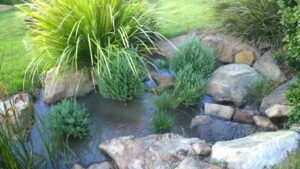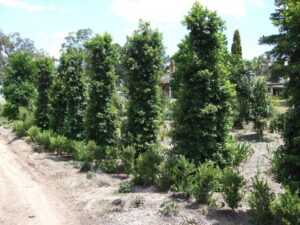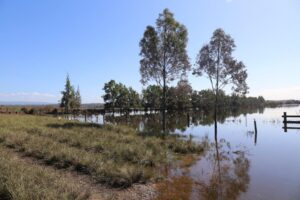
Performance breeding shaping the future of landscape plants
By Todd Layt
Main photo: Grey Box Westringia performs very differently than regular westringia in the wet (Image by Ozbreed Green Life)
In the verdant realm of landscape and ornamental plant breeding, a significant evolution is unfurling. Plants that were once cultivated purely for their aesthetic allure are now being bred with purposeful intent, optimising performance to meet specific needs. This progressive trend, known as “performance breeding”, is not only transforming the landscape industry but also redefining our perceptions of the role of plants and their value.
With the pressing urgency of environmental sustainability and technological advancements, the focus has shifted from mere looks to functionality. Performance breeding is enabling the development of robust plants that can withstand challenging conditions, be they extreme drought, waterlogging, increased humidity, or harsh cold. Another trend is breeding exotic plants so they are no longer weedy. Substituting with a weedy type could have disastrous consequences.

Performance breeding has also paved the way for tailoring plants to specific landscape areas. Whether it’s compact or narrow varieties for confined spaces like street medians or narrow fence lines, or disease-resistant plants for areas prone to specific pathogens, breeders are now able to create purpose-bred varieties that cater to these unique requirements. Breeders are enhancing many plants that can be grown outside their normal geographical area, for instance Western Australian plants such as Blue Horizon Eremophila that cope with the humidity of Sydney.

The paradigm shift brought about by performance breeding compels us to look beyond the surface. It’s no longer about the species or its aesthetic appeal; rather, the emphasis lies on the attributes of each newly bred variety. This rise of performance breeding necessitates a change in our evaluation process. Species-level generalisations no longer suffice, as they might not reflect the attributes of a specific variety. Instead, a nuanced, variety-specific assessment is required to appreciate the capabilities and value of each plant, highlighting the importance of individual variety over broad species categorisation. Agriculture thrives on this.
Plant substitution: an innocuous term that masks a potential nightmare in relation to performance plant breeding. The seemingly simple act of substituting one plant for another can escalate into a costly blunder, leading to replacement expenses, dissatisfied customers, and even court cases.

The perils of plant substitution loom large, with potential financial and reputational risks involved when the wrong plants are used or substituted. A glaring example is the disastrous substitution of wet feet tolerant Lomandra Shara with non-tolerant Lomandra Confertifolia in a Queensland bioretention swale, resulting in the death of all plants by the tens of thousands. Other examples of disastrous substitutions would include wet feet tolerant Grey Box or Mundi Westringia with all other non-water loving westringia in a wet environment, or a narrow Pinnacle Syzygium to fit a confined space, with a regular Lilly Pilly, only to find in five years time the plants do not fit in that space.
In essence, performance breeding is revolutionising the landscape industry, advocating for a shift from aesthetics to purpose. It underscores the importance of functional beauty, where each plant’s value lies not just in its visual appeal but in its bred-for-purpose performance abilities.
